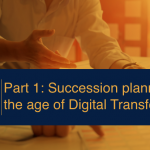Written by Ash
•
•
Our recent publications and thought leadership series focused a lot on succession planning because we genuinely believe that succession planning is a vital process in ensuring business continuity and is also a key strategy in retaining key talents. While the conversations in the HR world also resonate with these sentiments, it appears that there is a big gap between discussion and execution, which has widened further due to the pandemic. Here are 10 succession planning statistics that may surprise you.
COVID-19 Impact On Succession Planning – Whilst many organizations adopted the new norm of working quickly, the processes they had in place for succession planning were not agile enough to adapt as quickly. The delays in these organizations’ leadership development initiatives would only prolong the period until their successors are ready and therefore lessens their bench strength readiness.
- Only 7% of respondents said COVID-19 has not had any impact on their organization’s succession planning (I4CP, 2020)
- 70% reported that leadership development programs have been rescheduled or delayed (I4CP, 2020)
Succession Planning Has Bad ROI – Year after year companies are willing to spend huge amounts of money on succession planning practices and platforms, yet, when it comes time to see the return on their investment this often falls short. This has led to employees being unhappy with their organizations’ succession planning process and a discrepancy between how important succession planning seems against how well it’s actually done.
- Companies around the world spend $370 billion per year on leadership development (Training Industry, 2021)
- Yet, 5 out of 6 HR managers are dissatisfied with the results of their leadership development programs.(Gartner, 2016)
- And while 86% of leaders believe leadership succession planning is of utmost importance, only 14% think their organization does it well. (Deloitte, 2014)
Many Succession Planning Processes Are Not Data-Driven – Despite a shift to virtual work settings and the heavy investment into succession planning, surprisingly many organizations still rely on a more subjective approach or lack a formal process altogether. This means that many succession planning processes are still subject to bias, subjectivity, and inaccurate promotions.
- Only 35% of organizations have a formalized succession planning process. (ATD, 2019)
- At 73% of companies, the most common method for identifying individuals as potential candidates for leadership positions was a single nomination by their direct manager. (CrForum, 2016)
An Unsuccessful Succession Planning Process Can Be Costly – Failed succession planning either in its process or in the identification of successors can have a very significant impact on business performance. Every time an organization has to be reactive toward a position becoming vacant, they face significant revenue loss, lose shareholder value or end up with an unqualified successor.
- The direct cost of replacing a failed executive is close to 10x his or her salary. (HBR, 2017)
- Large companies that underwent forced succession would have generated $112 billion more in market value had they planned the succession better (Strategy-business, 2015)
- Companies that have to fire their CEO lose an average of $1.4 billion in shareholder value, compared with companies with a succession plan (Strategy-business, 2015)
These state of succession planning statistics paint a very different picture from the discussions companies are having about succession planning, showing that board-level conversations are not enough. Succession planning is essential in retaining talent, keeping them engaged, and ensuring a strong leadership pipeline. To see how complete your succession planning process is, use our checklist as a guide: Succession planning checklist






